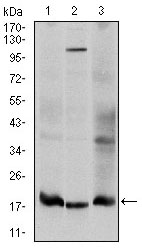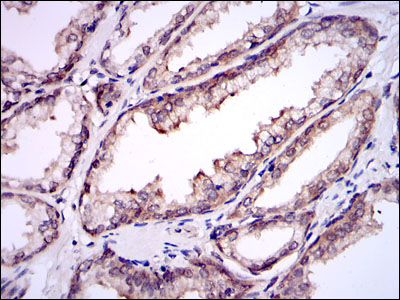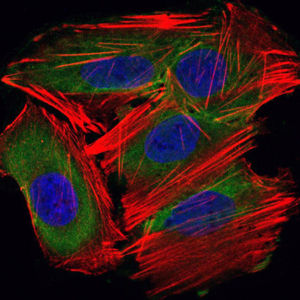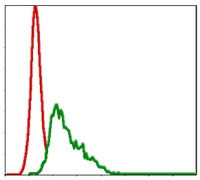UBC9 Monoclonal Antibody
- Catalog No.:YM0642
- Applications:WB;IHC;IF;FCM;ELISA
- Reactivity:Human
- Target:
- UBC9
- Fields:
- >>Nucleocytoplasmic transport;>>NF-kappa B signaling pathway;>>Ubiquitin mediated proteolysis;>>MicroRNAs in cancer
- Gene Name:
- UBE2I
- Protein Name:
- SUMO-conjugating enzyme UBC9
- Human Gene Id:
- 7329
- Human Swiss Prot No:
- P63279
- Mouse Swiss Prot No:
- P63280
- Immunogen:
- Purified recombinant fragment of human UBC9 expressed in E. Coli.
- Specificity:
- UBC9 Monoclonal Antibody detects endogenous levels of UBC9 protein.
- Formulation:
- Liquid in PBS containing 50% glycerol, 0.5% BSA and 0.02% sodium azide.
- Source:
- Monoclonal, Mouse
- Dilution:
- WB 1:500 - 1:2000. IHC 1:200 - 1:1000. IF 1:200 - 1:1000. Flow cytometry: 1:200 - 1:400. ELISA: 1:10000. Not yet tested in other applications.
- Purification:
- Affinity purification
- Storage Stability:
- -15°C to -25°C/1 year(Do not lower than -25°C)
- Other Name:
- UBE2I;UBC9;UBCE9;SUMO-conjugating enzyme UBC9;SUMO-protein ligase;Ubiquitin carrier protein 9;Ubiquitin carrier protein I;Ubiquitin-conjugating enzyme E2 I;Ubiquitin-protein ligase I;p18
- Molecular Weight(Da):
- 18kD
- References:
- 1. Cell Signal. 2009 Dec;21(12):1935-44.
2. Nat Struct Mol Biol. 2009 Sep;16(9):945-52.
- Background:
- The modification of proteins with ubiquitin is an important cellular mechanism for targeting abnormal or short-lived proteins for degradation. Ubiquitination involves at least three classes of enzymes: ubiquitin-activating enzymes, or E1s, ubiquitin-conjugating enzymes, or E2s, and ubiquitin-protein ligases, or E3s. This gene encodes a member of the E2 ubiquitin-conjugating enzyme family. Four alternatively spliced transcript variants encoding the same protein have been found for this gene. [provided by RefSeq, Jul 2008],
- Function:
- catalytic activity:ATP + SUMO + protein lysine = AMP + diphosphate + protein N-SUMOyllysine.,function:Accepts the ubiquitin-like proteins SUMO1, SUMO2, SUMO3 and SUMO4 from the UBLE1A-UBLE1B E1 complex and catalyzes their covalent attachment to other proteins with the help of an E3 ligase such as RANBP2 or CBX4. Essential for nuclear architecture and chromosome segregation.,pathway:Protein modification; protein sumoylation.,similarity:Belongs to the ubiquitin-conjugating enzyme family.,subunit:Interacts with HIPK1, HIPK2 and PPM1J (By similarity). Forms a tight complex with RANGAP1 and RANBP2. Interacts with SIAH1 and PARP. Interacts with various transcription factors such as TCF3, TFAP2A, TFAP2B, TFAP2C, AR, ETS1 and SOX4. Interacts with human adenovirus E1A and human herpesvirus 6 IE2. Interacts with RWDD3; the interaction enhances the sumoylation of a number of proteins such as HIF1A
- Subcellular Location:
- Nucleus . Cytoplasm . Cytoplasm, perinuclear region . Mainly nuclear (By similarity). In spermatocytes, localizes in synaptonemal complexes (PubMed:8610150). Recruited by BCL11A into the nuclear body (By similarity). .
- Expression:
- Expressed in heart, skeletal muscle, pancreas, kidney, liver, lung, placenta and brain. Also expressed in testis and thymus.
- June 19-2018
- WESTERN IMMUNOBLOTTING PROTOCOL
- June 19-2018
- IMMUNOHISTOCHEMISTRY-PARAFFIN PROTOCOL
- June 19-2018
- IMMUNOFLUORESCENCE PROTOCOL
- September 08-2020
- FLOW-CYTOMEYRT-PROTOCOL
- May 20-2022
- Cell-Based ELISA│解您多样本WB检测之困扰
- July 13-2018
- CELL-BASED-ELISA-PROTOCOL-FOR-ACETYL-PROTEIN
- July 13-2018
- CELL-BASED-ELISA-PROTOCOL-FOR-PHOSPHO-PROTEIN
- July 13-2018
- Antibody-FAQs
- Products Images

- Western Blot analysis using UBC9 Monoclonal Antibody against HeLa (1), HepG2 (2), and Cos7 (3) cell lysate.

- Immunohistochemistry analysis of paraffin-embedded prostate tissues with DAB staining using UBC9 Monoclonal Antibody.

- Immunofluorescence analysis of HepG2 cells using UBC9 Monoclonal Antibody (green). Blue: DRAQ5 fluorescent DNA dye. Red: Actin filaments have been labeled with Alexa Fluor-555 phalloidin.

- Flow cytometric analysis of HepG2 cells using UBC9 Monoclonal Antibody (green) and negative control (red).




